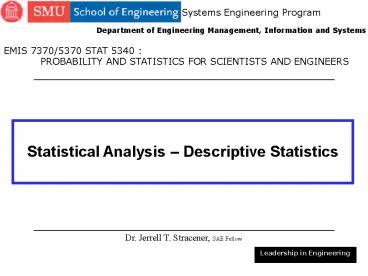Statistical Analysis - PowerPoint PPT Presentation
1 / 27
Title:
Statistical Analysis
Description:
Systems Engineering Program Department of Engineering Management, Information and Systems EMIS 7370/5370 STAT 5340 : PROBABILITY AND STATISTICS FOR SCIENTISTS AND ... – PowerPoint PPT presentation
Number of Views:199
Avg rating:3.0/5.0
Title: Statistical Analysis
1
Systems Engineering Program
Department of Engineering Management, Information
and Systems
EMIS 7370/5370 STAT 5340 PROBABILITY AND
STATISTICS FOR SCIENTISTS AND ENGINEERS
Statistical Analysis Descriptive Statistics
Dr. Jerrell T. Stracener, SAE Fellow
Leadership in Engineering
2
- Basic Concepts
- Analysis of Location, or Central Tendency
- Analysis of Variability
- Analysis of Shape
3
Population vs. Sample
Population the total of all possible values
(measurement, counts, etc.) of a particular
characteristic for a specific group of
objects. Sample a part of a population selected
according to some rule or plan. Why sample? -
Population does not exist - Sampling and testing
is destructive
4
Sampling
- Characteristics that distinguish one type of
sample - from another
- the manner in which the sample was obtained
- the purpose for which the sample was obtained
5
Types of Samples
- Simple Random Sample
- The sample X1, X2, ... ,Xn is a random sample if
- X1, X2, ... , Xn are independent identically
- distributed random variables.
- Remark Each value in the population has an
- equal and independent chance of being included
- in the sample.
- Stratified Random Sample
- The population is first subdivided into
- sub-populations for strata, and a simple random
- sample is drawn from each strata
6
Types of Samples - Continued
- Censored Samples
- Type I Censoring - Sample is terminated at a
- fixed time, t0. The sample consists of K times to
- failure plus the information that n-k items
- survived the fixed time of truncation.
- Type II Censoring - Sampling is terminated
- upon the Kth failure. The sample consists of K
- times to failure, plus information that n-k items
- survived the random time of truncation, tk.
- Progressive Censoring - Sampling is reduced in
- stage.
7
Types of Samples - Continued
- Systematic Random Sample
- The N items in the population are arranged in
- some order.
- Select an item at random from the first K N/n
- items, where n is the sample size.
- Select every Kth item thereafter.
8
Statistical Analysis Objective
- Data represents the entire population
- Statistical analysis is primarily descriptive.
- Data represents sample from population
- Statistical analysis
- - describes the sample
- - provides information about the population
9
Analysis of Location or Central Tendency
- Sample (Arithmetic) Mean
- Sample Midrange
- Sample Mode
- Sample Median
- Sample Percentiles
10
Sample Mean
11
Sample Mode
- Definition
- Most frequently occurring value in the sample
- Remarks
- A sample may have more than one mode
- The mode may not be a central value
- Not well understood, nor frequently used
12
Sample Median
13
Analysis of Variability
- Sample Range
- Sample Variance
- Sample Standard Deviation
- Sample Coefficient of Variation
14
Sample Range
- Formula R Xmax - Xmin
- where Xmax is the largest value in the sample
- and Xmin is the smallest sample value
- Remarks
- Easy to determine
- Easily understood
- Determined by extreme values
- Does not use all sample data
15
Sample Variance Standard Deviation
- Sample Variance
- Sample Standard Deviation
- s (sample variance)1/2
- Remarks
- Most frequently used measure of variability
- Not well understood
16
Sample Coefficient of Variation
17
Analysis of Shape
- Skewness
- Kurtosis
18
Estimate of Skewness
For a unimodal distribution, xr is an
indicator of distribution shape lt 1 ,
indicates skewed to the left xr 1 ,
indicates symmetric gt 1 , indicates
skewed to the right
19
Measure of Skewness
- The third moment about the mean is related to
- the asymmetry or skewness of a distribution
- For a unimodal (i.e., a single peaked)
distribution - ?3 lt 0 , distribution is skewed to the left
- ?3 0 , distribution is symmetric
- ?3 gt 0 , distribution is skewed to the right
- Measure of skewness relative to degree of spread
20
Comparison of Distribution Skewness
- Normal
- Exponential
21
Estimation of Skewness
- Estimate of skewness of a distribution from a
- random sample
- where
- and
22
Measurement of Kurtosis
- The fourth moment about the mean is related to
- the peakedness, called kurtosis, of a
distribution - Relative measure of Kurtosis
- where
23
Estimation of Kurtosis
- Estimate of kurtosis of a distribution (?2) from
a - random sample
- where
- and
24
Comparison of Kurtosis
25
Presentation of Data
26
40 Specimens
40 specimens are cut from a plate for tensile
tests. The tensile tests were made, resulting in
Tensile Strength, x, as follows
Perform a statistical analysis of the tensile
strength data.
27
40 Specimens
The following descriptive statistics were
calculated from the data































